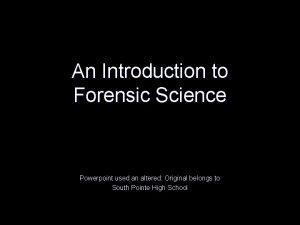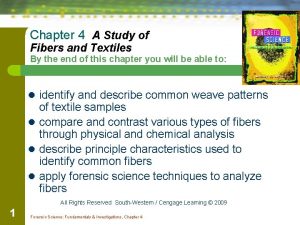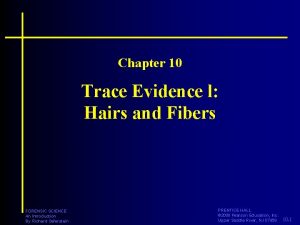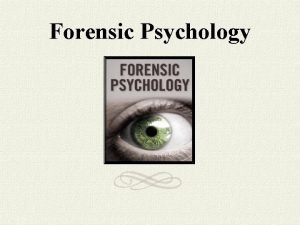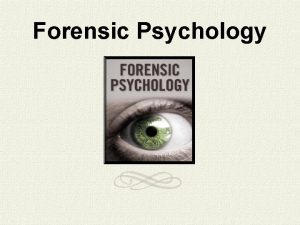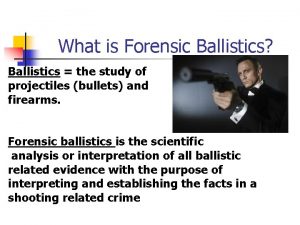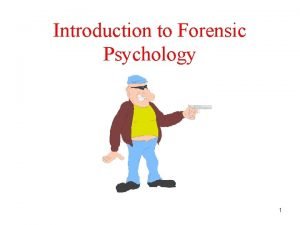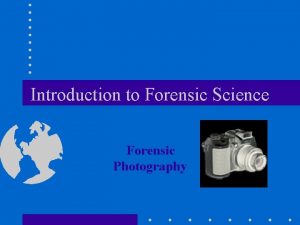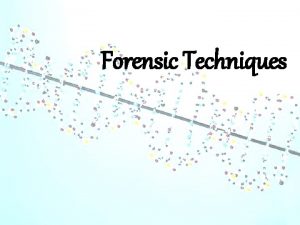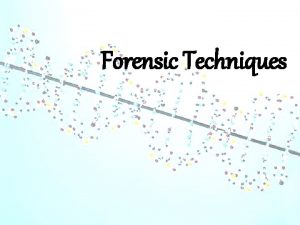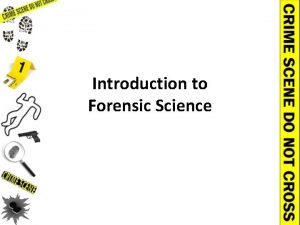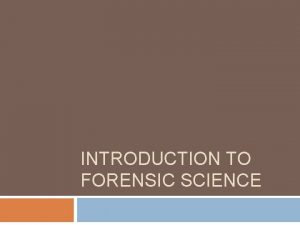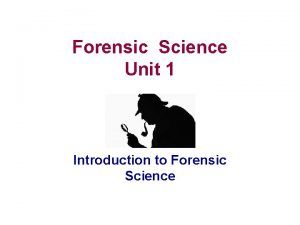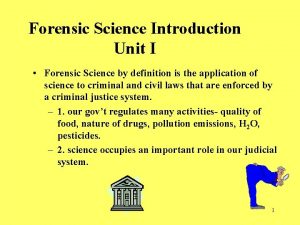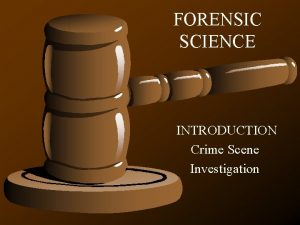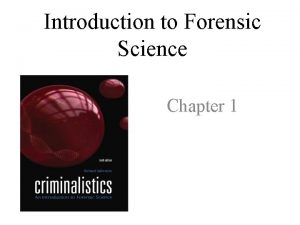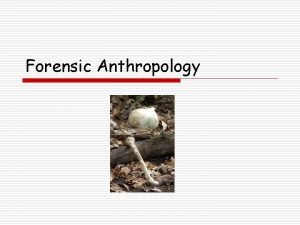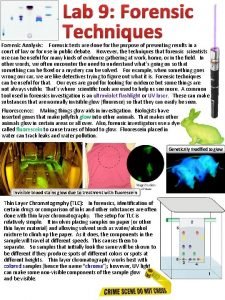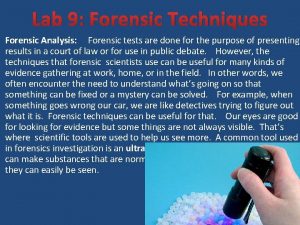Introduction and History of Forensic Science Your Entire





















- Slides: 21

Introduction and History of Forensic Science “Your Entire Being is a Matrix of Evidence Waiting to Be Left Behind…”

General Definitions • Forensic science is the scientific study of evidence to discover the facts in a criminal or civil matter. More specifically, for our purposes: the science applied to solve crimes • The term “forensic” is derived from Latin, meaning “of or before the forum. ” This refers to the ancient Roman practice of resolving disputes through speech in a public forum 2009© Forensic Science Today

People Important to Development of Forensic Science • 14 th Century Chinese- Forensic Medicine • Orfila (Spanish physician first to systematically use autopsy material & chemical analysis & legal proof of poisoning & Raspil- Toxicology

• Alphonse Bertillon, 1930 s: Anthropometry: a method of identifying criminals by their physical characteristics. This uses measurements of the head and body, facial characteristics, and mug shots of offenders. • Q: Can you think of problems that could arise with the use of body characteristics to identify criminals with anthropometry?

• William Herschel, 1877 - Fingerprinting. Herschel was a magistrate in India and began using them for registering land deeds, collecting pensions, and ensuring that convicts did not hire substitutes to serve their prison time. • In 1888 Francis Galton designed a form for recording inked fingerprinting impressions and defined the three main pattern types and in 1900 s, fingerprinting adopted by Scotland Yard who taught the St. Louis PD to use them at the 1904 World’s Fair in St. Louis, MO, thus spreading the practice to the US.

• Dr. Edmond Locard pioneered the use of trace evidence to solve crimes. He set up the first known crime lab.

• "Wherever he steps, whatever he touches, whatever he leaves, even unconsciously, will serve as a silent witness against him. Not only his fingerprints or his footprints, but his hair, the fibers from his clothes, the glass he breaks, the tool mark he leaves, the paint he scratches, the blood or semen he deposits or collects. All of these and more, bear mute witness against him. This is evidence that does not forget. It is not confused by the excitement of the moment. It is not absent because human witnesses are. It is factual evidence. Physical evidence cannot be wrong, it cannot perjure itself, it cannot be wholly absent. Only human failure to find it, study and understand it, can diminish its value. "

Locard’s Principal Note Taking Activity • Using the blank piece of paper & coloring pencils, make your “notes” however you deem appropriate for Locard’s famous principal. We will refer to this principal all year long, so do you best work. For example, use a house, stick man, broken glass bottle, spray paint can, etc…

More People in Forensic Science • Hans Gross, 1893 - first person to coin the term Criminalistics to refer to scientific methods of identifying, apprehending, and prosecuting criminals.

• Paul Kirk, 1950 s - helped establish criminology as an academic discipline through his work at the University of California, Berkely. He specialized in microscopy and provided key blood spatter evidence resulting in the acquittal of Sam Sheppard in his wife’s famous murder in 1955 (have you watched the movie The Fugitive ? )

DNA…nearly 100% accurate • 1986, DNA was used to solve a crime for the first time when DNA profiling identified Colin Pitchfork as the murderer of two young girls in England • Interestingly, the same case was also the first time DNA was used to exonerate an innocent suspect before Pitchfork was identified as the culprit

Where Forensic Scientists Work • • • Law enforcement agencies Forensic Labs Universities Hospitals Consulting offices

Ethics • Ethics are and extremely important part of working in forensic science. No matter which side they work for, forensic professionals must remain neutral at all times and prevent their personal feelings and opinions from getting in the way of discovering the hard facts. • They must also be sure their work is the very best they can do, tests are conducted correctly, written reports must be accurate, and testimony must be truthful, complete, ad objective. • Q: Why is this important?

Forensic Scientists at Work in Medical Examiner’s Morgue 2009© Forensic Science Today

Expert Witness • Determined by… – Education – Experience – Training – Cerification – Demeanor

Set-ups of Labs • Varies a lot! • Possible sections in a lab – Biology/DNA – Chemistry/Drug? Toxicoloy – Firearms/Toolmarks – Trace (not always ) – Arson/Explosives (not always)

Set-up of Labs Cont’d • Questioned Docs (not always) • Polygraph, voice Detection (not always) • Medical Examiner (usually a separate office)

Other Areas of Forensic Science • • Forensic Art Forensic Psychiatry Forensic Odontology Forensic Pathology Forensic Engineering Computer Forensic Jurisprudence (law)

Other fields are called upon to lend their expertise in solving particular aspects of a crime…. • • • Accountant • Aviation • Computer specialist • Environmental scientist • Medical investigator Image enhancement specialist • Forensic nurse Photographer Polygraph examiner Radiologist Speech scientist

The “CSI Effect” • Q: Class discussion: Why do you think CSI could be good/bad

“CSI Effect” cn’t… • Since 2000, shown in 200 countries with over two billion viewers (not to mention spin off shows such as Criminal Minds • Some Jury members have unrealistic expectations of forensic techniques used in criminal cases: – How quickly they can be solved – forensic analysis sometimes yields more than one result (sends the investigation in multiple directions) – Has changes the way some criminals commit crimes (attempt to destroy evidence) – On positive note, it has led to increase in applications to forensic science research programs at universities
 Chapter 1 introduction to forensic science and the law
Chapter 1 introduction to forensic science and the law Forensic science ppt
Forensic science ppt Important people in forensics
Important people in forensics Forensic science unit 1 review
Forensic science unit 1 review Forensic science an introduction
Forensic science an introduction Forensic anthropologist vs forensic pathologist
Forensic anthropologist vs forensic pathologist Who is this
Who is this Fitness is the ability to
Fitness is the ability to What type of footwear protects your entire foot
What type of footwear protects your entire foot Think central k5
Think central k5 My favourite subject science
My favourite subject science Chapter 6 fingerprints
Chapter 6 fingerprints A study of fibers and textiles
A study of fibers and textiles Hairs and fibers in forensic science
Hairs and fibers in forensic science Forensic psychology history
Forensic psychology history History of forensic psychology
History of forensic psychology Veronica scotti
Veronica scotti Bullet cavitation
Bullet cavitation History of forensic psychology
History of forensic psychology Libie motchan
Libie motchan Hegar's sign
Hegar's sign What is meant by the morphology of hair
What is meant by the morphology of hair

